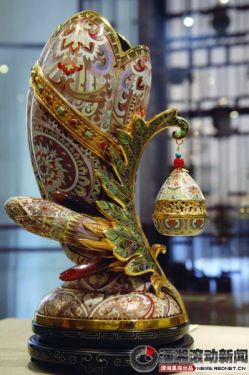 For Changsha citizens, the name "Cetailan" may have been mostly seen in Ye Shengtao's article "Creating Cloisonne."
For Changsha citizens, the name "Cetailan" may have been mostly seen in Ye Shengtao's article "Creating Cloisonne." This time, Changsha citizens can feast on their eyes. From yesterday to November 26, 38 pieces of cloisonne works will be exhibited at Changsha City Museum free of charge. These exhibits are from the hands of three national arts and crafts masters. At the exhibition site, the master will also demonstrate the production process of cloisonne.
What 38 pieces of cloisonne treasures collectively appeared at the scene? “One afternoon, we went to visit the experimental factory of Beijing Handicraft Co., Ltd. We saw roughly the production process of cloisonne. Cloisonne is the favorite arts and crafts for most people. Now let's talk about its production process. In 1955, Ye Shengtao, the writer, left behind his famous work "The Production of Cloisonne" and later selected the "Language" textbook.
Yesterday afternoon, Li Na, a language teacher at the Central Primary School in Huangcheng Town, Wangcheng District, took the students into the Changsha City Museum and began a visit to Mr. Ye Shengtao’s visit. For the first time, she saw the works of cloisonne and graceful cloisonne. Li Na was quite excited. “What is cloisonne? I only learned about it in middle school textbooks. It looks like a porcelain now. It looks really good!â€
Before the showcase, I heard that the collection of the work “ç½â€ was worth 100,000 yuan. Li Na could not help but whisper. “Is it worth looking at something like porcelain?†Zhong Liansheng, a master craftsman of Chinese crafts who came from Beijing, smiled and dispelled her. “The cloisonne aka “Bronze Tire†is historically known as an enamel device. Its production utilizes both bronze and porcelain craftsmanship, but also incorporates traditional hand-painting and carving techniques, and is a masterpiece of Chinese traditional craftsmanship. â€
Among the exhibited works, the "Liquor-shaped bottle" designed by the deceased master Qian Meihua has attracted much attention. This statue of cloisonne with a height of 31 centimeters is decorated with bats, cranes, and peaches to form auspicious patterns. The main part of the painting is gilded with a grain pattern. The group of white cranes in the light has a title of peach, meaning longevity and abundance. According to Zhong Liansheng, Qian Meihua was honored as the “China's first person in cloisonne†and she was one of her masterpieces. In addition, she won the “Cycle of the Cycle†at the Chinese Arts and Crafts Gold Flower Bowl Award. Debut.
In addition to Qian Meihua, several pieces of works by Zhong Liansheng and Zhang Tonglu were also exhibited, with a total of 38 exhibits.
Cloisonne's secret and high-quality work features a smooth and delicate surface. Zhong Liansheng introduced that 30 pieces of exhibits on display each produced 60 pieces out of print, 3 of which were targeted to the Changsha collectors.
When it comes to how to collect and identify the advantages and disadvantages of cloisonne works, Zhong Liansheng suggests that we should first look at the appearance. “The surface of high-quality cloisonne works should be smooth and delicate. If there is a sense of convexity and concaveness in the touch, it means that it is polished but it has no impurities or impurities. Cloisonne The materials used for the carcass of the products are very expensive. Counterfeiters often use very thin copper tires for the purpose of cost savings. They are prone to dents and bulges.†In addition, Zhong Liansheng said that the outstanding cloisonne works are beautifully patterned, with uniform pattern spacing, and sparse. Meticulously, pigments are also good mineral pigments.
The production process reveals three processes on-site and takes 40 minutes. As Ye Shengtao said in the production of cloisonne, a total of 108 processes are required for cloisonne production. “At present, there are only a few hundred people who understand the craftsmanship at home.†Zhong Liansheng told reporters that this exhibition, organized by the Chinese Arts and Crafts Association, aims to allow more people to understand the cloisonne process.
At the exhibition site, Zhong Liansheng brought some materials and tools for the audience to demonstrate the production process of cloisonne. "The first thing to do is to make a copper tire. This is the basic shape of the work. It must be made of copper. Brass can't be used because copper is softer." Next, Zhong Liansheng took out a special braid and folded the copper wire in his hands. Curved, then bent, and after a while, it becomes a flower shape. “This is the silk, stick it on the copper tire, and then burn it with fire, blue, gold...†Zhong Liansheng explains while doing it. It took about 40 minutes to demonstrate the three procedures of making a fetus, reeling, and spotting blue. "There are 108 roads in total, and it takes an average of four months to make a Cloisonne." Zhong Liansheng said.
Glossary Cloisonne: A porcelain-copper-clad handicraft. The history of manufacture can be traced back to the Yuan dynasty. During the Ming dynasty, Jingtai was the most popular because it used blue more, hence the name cloisonne. It is a decorative artwork in the Ming and Qing dynasties and is known as the Chinese national quintessence.
Custom Badge Factory,Anniversary Pin Badge,Custom Metal Badge
Key Chains,Lanyard,Badges,Silicone Wristband Co., Ltd. , http://www.cnkeychains.com